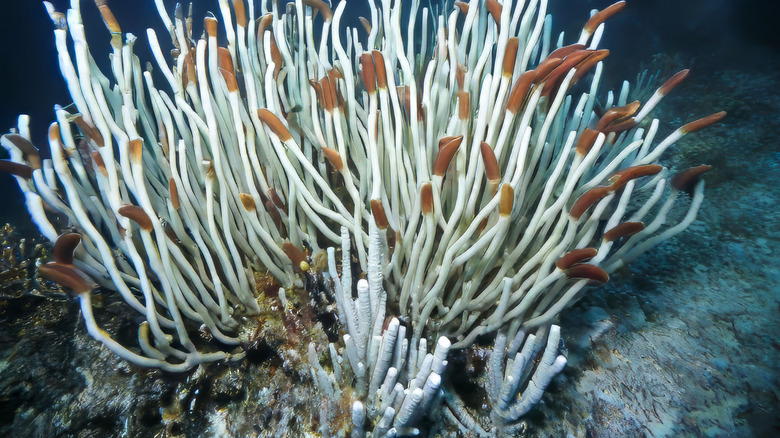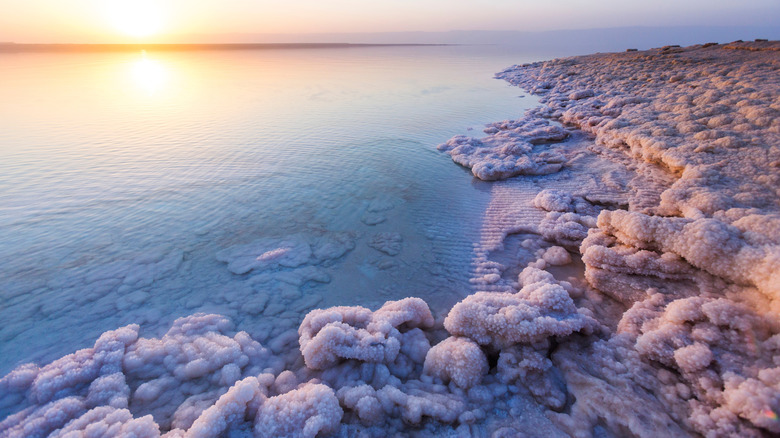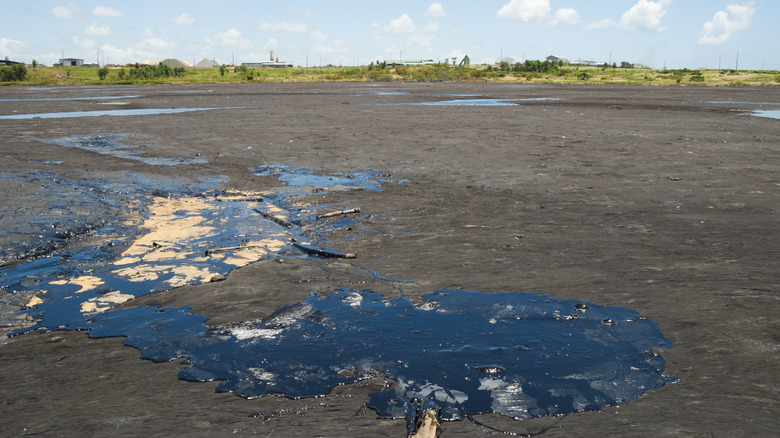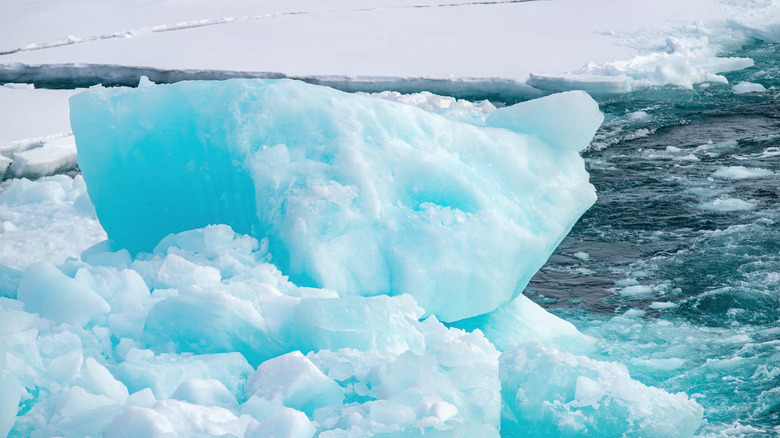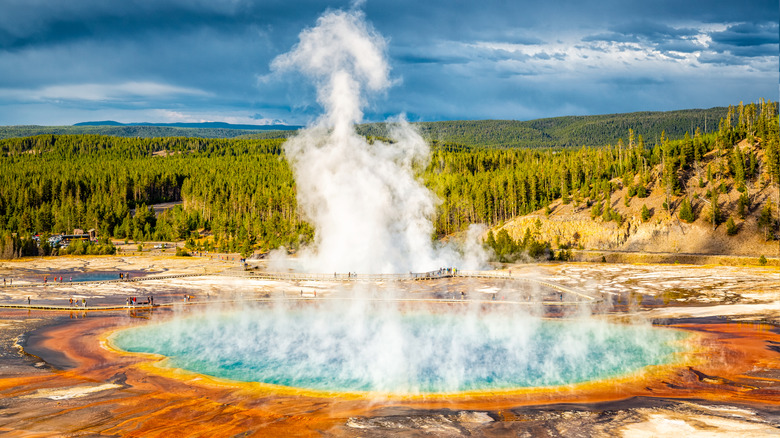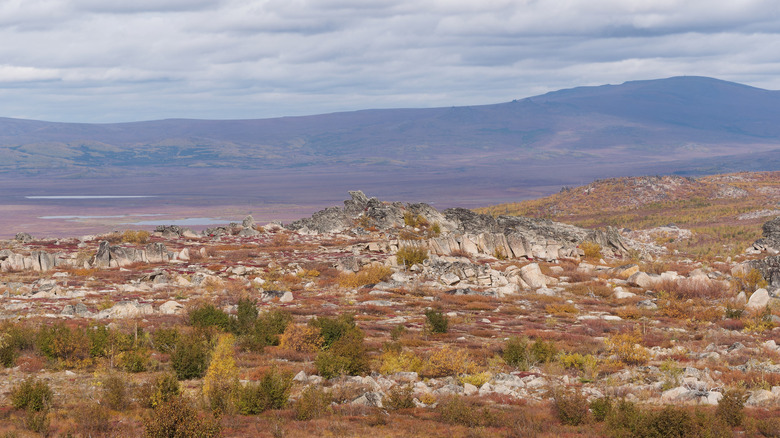10 Most Extreme Environments Where Scientists Were Shocked To Discover Life
Extreme environments are found all over the universe, but many of them are found right here on Earth. Generally speaking, an environment might be considered extreme if there are certain physical and chemical-based factors that might prevent life from surviving and flourishing. Among some of these factors include significant heat, freezing temperatures, boiling water, acidity, and more.
However, despite these extreme features, scientists have uncovered certain life forms that have seemingly defied the odds and survived in certain environments. These are also known as "extremophiles." In some cases, not only do these forms of life survive, but they continue to thrive under extreme circumstances, too. Among these include animals exclusive to certain extreme environments, microorganisms and their characteristics, marine life, and even specific types of amphibians. It's worth noting that while some of these environments may not be friendly to humans and other mammals, but this doesn't mean they are completely life-free. As scientists continue to access and study various extreme environments on Earth, there will undoubtedly be more life forms uncovered in the future.
Certain microorganisms can survive the harsh McMurdo Dry Valleys
Located in Antarctica, the McMurdo Dry Valleys are considered one of the most difficult places for life to exist. This vast area covers about 1,850 square miles and is composed of a combination of dry soil and frozen lakes. Not only are the McMurdo Dry Valleys extremely cold, but they are also extremely salty, windy, and dry. When humans first explored the region in the early 20th century, they assumed there couldn't be any life forms in this desolate area. However, while there are no visible life forms on the surface of the McMurdo Dry Valleys, certain microorganisms have managed to survive underneath the ice.
Cyanobacteria are thought to be the primary life forms that can survive and thrive in this extremely harsh environment. Scientists believe their survival is partially due to the fact that the lakebeds they thrive on go relatively undisturbed by other species. Also, cyanobacteria have the ability to start photosynthesizing is less than 48 hours of receiving water. Despite the limited number of organisms that live in the McMurdo Dry Valleys, researchers are interested in keeping tabs on them as a sort of base for determining how extreme changes in the climate can potentially disrupt basic ecosystems.
Certain life forms are unique to the Mariana Trench
The Mariana Trench is arguably one of the most fascinating places on Earth, and it is among the list of the world's deepest ocean trenches. Additionally, its location also means that about 50,532,100 acres have yet to be explored by humans. The deepest point runs 35,876 feet, which is more than the height of Mt. Everest. Since it is the deepest part of the entire earth, humans have long wondered what types of life forms can survive here, if any. This is especially true of areas surrounded by hydrothermal vents, which could plausibly make it difficult to live nearby. It turns out that the Mariana Trench supports a multitude of life, many of which have unique characteristics.
First, scientists have uncovered numerous microorganisms within sediments of the Mariana Trench, many of which are in the "hadal zone," or those that are between 20,000 and 36,000 feet below sea level. Aside from its depth, the hadal zone is also known for its almost-freezing temperatures, high pressure, and complete darkness. As such, scientists have been surprised to find other life forms at the depts of the Mariana Trench. Many of these are bioluminescent, which is a necessity for these animals to be able to communicate with one another. Among some of these creatures that call the Mariana Trench home include bioluminescent fish, octopuses, and sharks. However, there could be many more life forms yet to be discovered within these depths.
Surprising deep sea life forms exist along the East Pacific Rise
The East Pacific Rise is a tectonic plate boundary in the eastern Pacific Ocean that also consists of underwater volcanoes. Not only is the seafloor rampant with volcanic activity, but this area is also known to cause shallow-water earthquakes. What's more, the southern portion is moving at an astonishing 6.3 inches every year, and the area is filled with hydrothermal vents. In spite of all of these factors, scientists have found that life not only exists near the East Pacific Rise, but some of the volatile activities are even supportive in some cases.
Until recently, scientists thought that only viruses and microorganisms like bacteria lived around the seafloor of the East Pacific Rise. To their surprise though, researchers confirmed this as a strange place to find life in the Pacific Ocean based on additional findings. These include other forms of life in hydrothermal vents, including snails, worms, and tubeworms. While the exact circumstances are still unknown, researchers believe these lifeforms may have previously been drawn inside the earth's crust and subsequently adapted to the new environment. Also, despite the extremely hot water temperatures caused by volcanic hydrothermal vents, these underwater hot springs actually help support bacteria that feed on sulfide minerals.
Dead Sea supports certain microorganisms
Many people have wondered if anything can live in the Dead Sea, and rightfully so. In general, the Dead Sea is known as a pretty unsupportive environment for most life forms. Known for its extremely high salt content of between 19% and 26%, the Dead Sea is actually a large lake surrounded by Jordan, Israel, and portions of Asia. It receives almost all of its water from the Jordan River, which can also sometimes bring in fish. Sadly, due to the salinity of the Dead Sea, such fish cannot survive in this lake for very long.
Not only is the Dead Sea largely devoid of animal life, but most plants cannot survive along its banks, either. Despite all these facts, scientists were surprised to discover that certain types of bacteria can thrive in this high-salinity environment. It's thought that these microorganisms have developed a salt tolerance to be able to survive and thrive in the Dead Sea. However, these exact mechanisms have yet to be fully understood.
An underwater volcano supports a variety of marine life
Depending on the different types of volcanoes and their characteristics, land volcanoes can be known for their large, gaseous explosions, or their fascinating lava flows that eventually create new land. However, most of the world's volcanoes are located under the sea. These are also known as submarine volcanoes, and they can spew lava and gases like their above-ground counterparts. One such example is the Kavachi volcano, which is located near the Solomon Islands in the Pacific Ocean. Despite its designation as an active volcano and the fact that its base reaches over 3,600 feet under the water, it turns out that this submarine volcano is home to a variety of marine life.
Before their expedition to the Kavachi volcano in 2015, scientists were likely expecting to find smaller forms of life around the area. What surprised them, however, was the presence of larger animals, such as sharks. On top of this discovery, the team also noted that the sharks lived inside the active crater of the volcano, along with other smaller fish. Since then, researchers have been working to understand how these marine animals can live in such a volatile environment, and whether they can determine an imminent eruption from Kavachi and subsequently evacuate the area.
Microorganisms thrive within a Caribbean tar lake
When you think of tar, you might refer to the dark, thick, and oily substance that is used in a variety of industries, including construction, plastics, and certain medications. You might also perceive tar as a substance that is void of any life. However, one tar pit in the Caribbean has proved this theory wrong. Such is the case with Pitch Lake, which contains a combination of asphalt and hydrocarbons.
Located in the island country of Trinidad and Tobago, Pitch Lake is a tar pit-like hydrocarbon lake that is thought to be similar to those found on Saturn's Titan moon. While poisonous to humans, Pitch Lake is home to several single-celled organisms that survive on hydrocarbons. What's perhaps even more fascinating is the lack of water needed for these particular microorganisms to survive in the tar lake. Researchers are taking this information to help determine better ways to possibly break down oil. What's more, the ability for life to survive and thrive in the tar pits of Pitch Lake could possibly open up future discoveries of life forms on other planets.
Sea ice at the North Pole contains a multitude of life
While the occasional polar bear, bird, or human might visit the North Pole, these species do not live full time in this unpredictable, icy portion of the Arctic Ocean. Scientists have instead discovered a variety of microbes in sea ice here, as well as thriving undersea ecosystems. In fact, it is estimated that about 1 million bacteria can live in just 1 milliliter of sea ice alone. For context, it's important to know that the North Pole is typically covered with ice that ranges between 6 and 10 feet in thickness.
As scientists have continued to research sea ice in the North Pole region, they have found more than bacteria, though. It is now thought that this thick sea ice is also home to a variety of algae, fungi, viruses, and types of archaebacteria. These are also a testament to the fascinating ways in which life can evolve to survive in extreme temperatures — in this case, it is ice that can get as cold as negative 31 degrees Fahrenheit. Researchers believe that these life forms not only play an important role in the ecosystem within the Arctic Ocean below, but their ability to adapt to increasing temperatures and sea levels associated with climate change can also provide insights.
Unique microorganisms in Yellowstone National Park's hot springs
Given their extremely high temperatures, hot springs are not places you might expect to see many life forms. This includes Yellowstone National Park's famous hot springs. While the exact temperatures can vary, the hot springs consist of water that can exceed temperatures of 198 degrees Fahrenheit, which has also unfortunately been the source of accidental deaths among visitors who contact the water. It turns out, however, that this extremely hot water is not lifeless. On the contrary, these hot springs are home to "thermophiles," which are microorganisms that live and thrive in extremely hot temperatures.
Thermophilic microorganisms that can survive in hot temperatures like hot springs and geysers primarily include bacteria, such as eubacteria and phototrophic bacteria. Cyanobacteria are some of the most common bacteria found in Yellowstone's hot springs. While cyanobacteria cannot be seen with the naked eye, one telltale sign of their presence is the orange sponge-like substances you might see floating around these hot springs. Researchers are also particularly interested in studying these thermophiles due to their connection with the evolutionary processes of animals on Earth. This includes oxygen-using species such as humans. Other forms of life have been found in acidic environments within Yellowstone National Park. These include a variety of algae species, some of which can live below a pH of 1. (For comparison, researchers have established the ideal human blood pH as ranging between 7.35 and 7.45.)
Mt. Everest is home to a surprising variety of life
Situated between China and Nepal, Mt. Everest is the world's tallest mountain. The extremely high elevation of 29,032 feet continues to draw explorers and extreme athletes to its summit every year, with the dangerous trek accounting for more than 300 known deaths. Indeed, the harsh conditions can explain why the Mt. Everest death toll is so high. While the valleys of the mountain are home to some people, such as the Sherpas, the region is largely considered uninhabitable by humans more generally. This is particularly the case at elevations higher than 14,000 feet.
Given these facts, you might assume that wildlife cannot survive the extreme heights of Mt. Everest either. Over the years though, researchers have discovered a surprising number of life forms that call Everest home. Livestock accompany many of the human inhabitants of the valleys, and the area is also home to a variety of birds, snow leopards, and bears. A research team in 2019 also found evidence of at least 16% of taxonomic orders on the southern flank of the mountain alone. These findings could suggest there may be much more life waiting to be discovered on Mt. Everest — the key, of course, is getting there.
Hibernating wood frogs in extreme northern Alaska
The Gates of the Arctic National Park and Preserve is one of the most remote wilderness parks in the world. While skilled visitors can technically backpack their way through the region any time of the year, you are most likely to see wildlife in the summer months when a variety of animals migrate to this isolated region of northern Alaska. During the wintertime though, the extreme temperatures of both northern Alaska and Canada can understandably turn this area into a seemingly lifeless landscape. That's why scientists were surprised to discover hibernating wood frogs north of the Arctic Circle.
Scientists have found that Alaska's wood frogs (Lithobates sylvaticus) have the ability to freeze during the harsh winter months when temperatures drop to minus 50 degrees Fahrenheit or lower. Unlike most types of frogs in the region that avoid freezing to death by hiding under water, these wood frogs literally freeze themselves for the winter. It's thought that wood frogs stay frozen for about eight months out of the year by hiding underneath fallen leaves in the forests of the region. Here, they freeze while their bodies concurrently emit glucose that allows the outside of their body cells to freeze, but not the inside. When warmer spring temperatures come back, the wood frog then defrosts itself from the inside out. While researchers have determined these processes, the fact that the wood frogs survive frozen for most of the year is still not fully understood.



